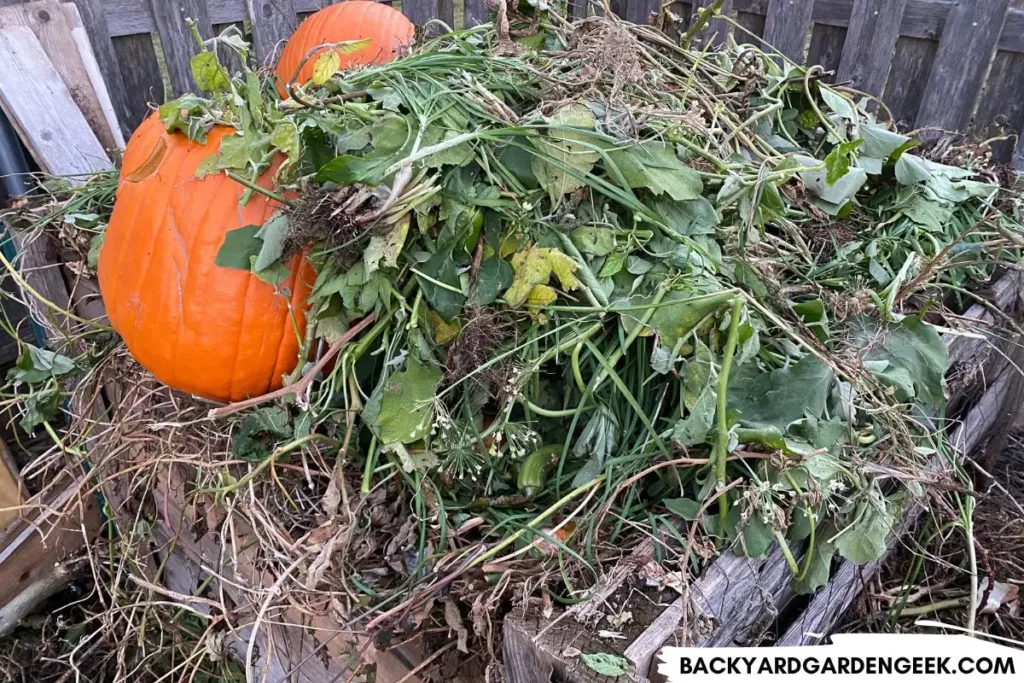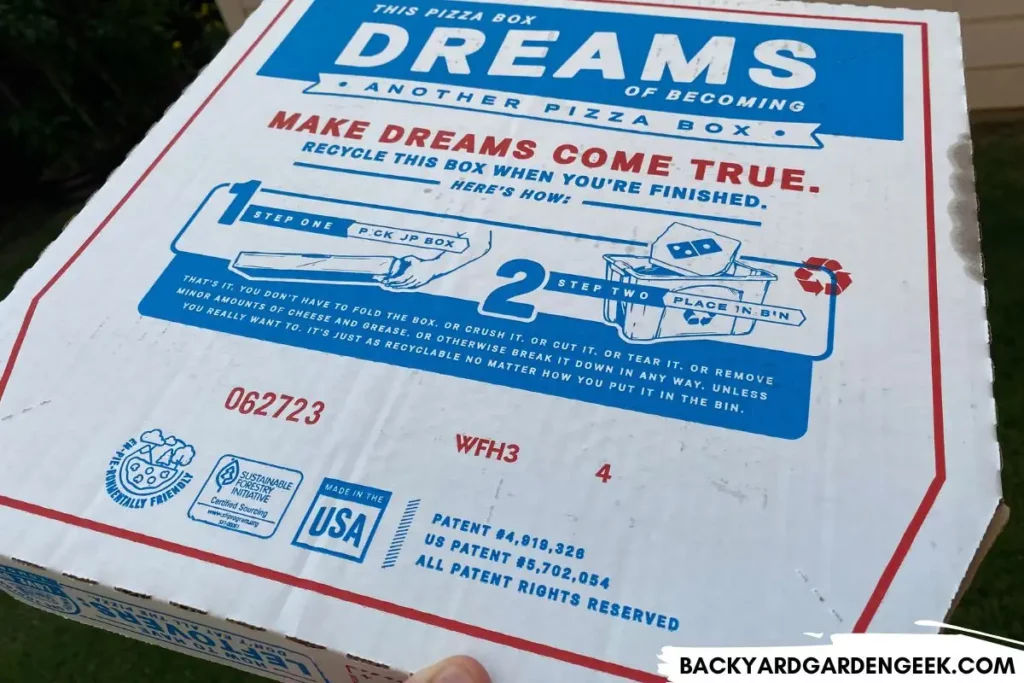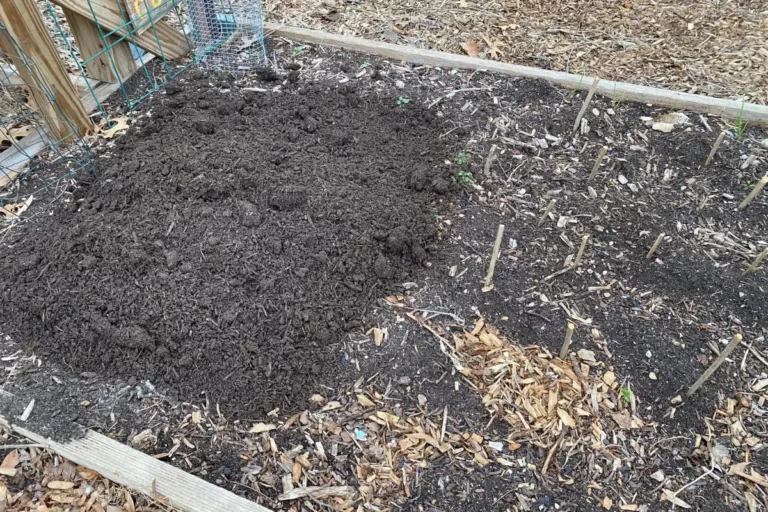Should I Put Cardboard at the Bottom of My Compost Bin?
Composting is one of the cheapest ways to create great garden soil, turning kitchen scraps and yard waste into rich, nourishing soil amendments.
But when you set up a compost bin for the first time, you might be wondering about what to put at the bottom of your bin.
Should you put cardboard at the bottom?
Placing cardboard at the bottom of a compost bin is an effective way to kill off native grasses and smother weed seeds while adding carbon-rich material to the bin. Cardboard should be non-dyed and free of packing tape or shipping labels since those won’t decompose during the composting process.
When installing a new compost bin or pile, you’ll want to make sure things get off to the right start, so in this article, I’ll touch on the following topics:
- The best way to use cardboard when installing a new compost bin or pile.
- The reasons why cardboard can aid in the composting process.
- The time it’ll take cardboard to decompose in your compost.
- Different materials you can put on top of the cardboard to get your compost working quickly.
If you spend just a few minutes reading my recommendations below, you’ll better understand how cardboard can help with your compost and what you need to do before and after you set up your compost bin or pile.
Before we begin, you might want to check out these high-capacity, cross-cut shredders. They’ll be a huge help (if you’re interested in doing more than adding cardboard to the bottom of your compost bin or pile) since they’ll chop up the cardboard into tiny pieces that’ll decompose in 2-3 months.
Now that I’ve covered some basics, let’s take a close look at what you can do with cardboard when composting.
Should I Line My Compost Bin with Cardboard?

Creating the perfect composting environment can be a bit of a juggling act. You need to manage components like temperature, moisture, and materials, all while keeping unwanted elements like weeds and pests out of there.
That’s where cardboard can come into play.
When you’re setting up a new compost bin or pile, I recommend placing 2-3 layers of cardboard on top of the soil.
The cardboard will act as a natural grass and weed killer, blocking sunlight and making it harder for these unwanted plants to sprout up through your compost.
Here’s exactly what you should do when adding cardboard:
- Make sure it’s not dyed (or that the dyes are organic dyes, like those found on cardboard pizza boxes).
- Avoid cardboard that feels like it’s got a plastic-like coating on it. I’m not sure what those chemicals are, but you likely don’t want them in your compost bin.
- Peel off any tape. That sticky stuff won’t compost and will just cause you headaches later on. Get rid of it!
- See any packing labels? Best to rip them off, or at least rip off as much as you can. There’s no reason to add potentially non-compostable materials to your bin, even if it’s at the very bottom of it.
As your compost pile grows larger, the cardboard you line the bottom with will disintegrate, usually in 6-8 months, releasing carbon into your compost and providing a nutrient boost right at the base of your pile.
Let’s look at the key advantages of placing cardboard at the bottom of your compost bin or pile:
- Weed and Grass Control: The cardboard creates a barrier that suppresses weed and grass growth underneath your compost pile.
- Moisture Capture: Cardboard absorbs moisture, keeping things nice and moist at the bottom of your pile.
- Carbon Boost: As the cardboard decomposes, it enriches your compost with carbon, an essential element for compost health.
But just because you line the bottom of your compost pile with cardboard, that doesn’t mean you should line the sides of it with cardboard as well.
Good composting requires adequate aeration, and lining the sides with cardboard could stifle this (even if it’ll decompose over time).
Instead, opt for materials like wood pallets, wooden slats, or chicken wire. These materials will keep your compost contained while still ensuring everything gets plenty of air.
If you’re planning to use a compost tumbler instead of a bin or pile, simply lay several layers of cardboard on the soil where you’ll place the tumbler. Position the tumbler on top and cover the surrounding area with more cardboard, then top with a thick layer of mulch.
This approach prevents grass and weeds from growing around the base of your composter and also gives the area a tidier overall look.
What Should I NOT Put in the Bottom of My Compost Bin?
Similar to raised garden beds, you’ve got lots of options when it comes to carbon-rich and nitrogen-rich materials you can add to the bottom of your compost bin.
However, you’ll want to exercise caution when it comes to adding larger materials to your compost. The bigger they are, the longer they take to compost, which can delay your compost pile’s decomposition progress.
Here’s what you should steer clear of when adding materials to your compost:
- Logs
- Branches
- Large sticks
- Sheets of unshredded cardboard

You should also be sure to keep these 50 plants out of your compost bin. And be sure to avoid composting these 30+ weeds since you can unwittingly create a mess for yourself!
Cardboard sheets are excellent for the bottom of your compost bin, but if you’re going to add cardboard to the compost itself, you’ll need to shred it first (as finely as possible).
If you’re wanting to compost your cardboard boxes from Amazon or toss your pizza boxes in the composter, you’ll want to invest in a high-quality paper shredder.
At a minimum, purchase a 12-sheet capacity shredder, but the more heavy-duty, the better.
Opt for a model that does cross-cuts to end up with small cardboard pieces. These pieces are a composting dream, decomposing rapidly and contributing to the health of your compost pile.
That being said, here are the pros and cons of shredding cardboard for your compost bin.
Advantages of Shredding Cardboard
- Speedy Decomposition: Smaller pieces of cardboard break down much faster, accelerating the composting process.
- Moisture Capture: The small bits of cardboard can absorb excess moisture, maintaining a balanced compost environment.
- Carbon Addition: Cardboard will add necessary carbon to your compost pile. As long as you’re balancing the compost by adding nutrient-rich materials, you’ll have some healthy compost.
- Recyclable Materials and Landfill Waste: When you compost cardboard, you reduce the volume of material that heads to recycling facilities and landfills. Increasing the eventual health of your garden soil while decreasing your carbon waste sounds like a great plan to me!
Disadvantages of Shredding Cardboard
- Time Intensive: Shredding cardboard can be a little time-consuming (if you don’t have a high-quality shredder), especially if you have a significant amount to process. You can cut the cardboard into strips, but I’ve done that before, and it’s not fun at all. Takes way too much time!
- Equipment Needs: You need to invest in a shredder, and shredders aren’t cheap and will inevitably break down at some point. I’ve got a shredder that’s lasted for 10 years—which feels a little lucky, if I’m being transparent—so good shredders will last for quite some time.
Whether or not you decide to shred your cardboard depends on how much time and resources you’re willing to invest.
If done right, you can get rid of unwanted boxes and create a well-balanced compost environment all at the same time!
How Does Cardboard Help Compost?
When you compost, you must work to maintain a balance between carbon-rich materials (“browns”) and nitrogen-rich materials (“greens”).
Achieving this balance is key to creating healthy garden compost, and cardboard can play a helpful role in this process.

Here’s why it’s important to maintain a balanced compost pile:
- Decomposition Speed: A balanced carbon-to-nitrogen ratio helps speed up the decomposition process, turning your kitchen scraps and yard waste into rich compost faster.
- Preventing Foul Odors: Too much nitrogen can lead to a smelly compost pile. Balancing it with carbon-rich materials helps prevent unpleasant odors.
- Disease Prevention: An unbalanced compost pile can harbor harmful bacteria and pathogens. A balanced pile promotes beneficial microbes that break down waste safely and effectively.
If you’re not careful about keeping your compost at least somewhat balanced, several problems can arise:
Too Much Nitrogen
- Foul Smells: As I noted above, excessive nitrogen can cause your compost pile to smell like ammonia or rotten eggs. This is one of several reasons why you should never build a compost pile near your home (if you can avoid it).
- Slow Decomposition: Too much nitrogen-rich material can slow down the decomposition process.
- Leachate Production: An overabundance of nitrogen can lead to the production of leachate, a liquid runoff. Backyard compost bins won’t cause much of a problem when it comes to leachate, but larger compost facilities can pollute groundwater and nearby waterways if they don’t keep things under control.
Too Much Carbon
- Slow Decomposition: A pile with too much carbon will decompose very slowly as there aren’t enough nitrogen-rich materials to fuel the composting microorganisms.
- Dry Pile: Excessive carbon can absorb too much moisture, leading to a dry and inactive compost pile. This is especially problematic during the warm summer months. I once saw a compost pile start smoking because it got too dry and nearly caught on fire!
- Poor Nutrient Content: A carbon-heavy pile will result in compost with lower nutrient content, which is less beneficial for your plants.
Thankfully, you can do several things to ensure your compost pile maintains a healthy carbon-to-nitrogen balance:
- Know Your Materials: Familiarize yourself with what materials are high in carbon and nitrogen. Kitchen scraps and green yard waste are generally nitrogen-rich, while dry leaves, straw, and cardboard are high in carbon.
- Maintain the Correct Ratio: Aim to maintain an appropriate carbon-to-nitrogen ratio. Cornell University recommends a 30 to 1 ratio of carbon to nitrogen. Other researchers recommend a 25 to 35 to 1 ratio of carbon to nitrogen. This means you should have roughly 30 times more browns (by weight) than greens in your compost pile, but it doesn’t have to be an exact science. Just do your best!
- Turn Your Compost: Regularly turning your compost pile will help distribute materials evenly and aids in faster decomposition.
- Moisten Your Compost: Is it getting really hot outside? Does your bin or pile look a bit dry? If so, your compost might need a little moisture to help with decomposition.
- Adjust as Needed: Adjust your materials if your compost pile develops an odor or seems to decompose slowly. Add more browns if it’s smelly (too much nitrogen) or more greens if it’s slow (too much carbon).
Cardboard, with its high carbon content, can be a great “brown” addition to balance out the “greens” in your compost pile since it’s a cheap yet effective way to create great compost.
Next time you’ve got cardboard boxes, you can line the bottom of your next compost pile or bin with them or shred them up and toss them in any time you need more carbon materials.
You’ll be amazed at how quickly they disintegrate into a rich soil amendment!
How Long Does It Take for Cardboard to Decompose?

Speaking of disintegration, you might be wondering: How long does it take for cardboard to decompose?
Generally speaking, cardboard that’s been added to the bottom of your compost pile will decompose within a year, but the answer to that question largely depends on how you introduce cardboard into your compost.
If you place entire sheets of cardboard into your compost—tossing them in with little thought to what happens next—it might take anywhere from 6-8 months or more for them to fully decompose.
This is primarily due to the larger surface area and the effort it’ll take for microbes to break them down.
On the other hand, thin strips of cardboard decompose a bit faster, potentially breaking down in 3-6 months (depending on the size). This is because the increased surface area exposed to microbes helps speed up the decomposition process.
Shredded cardboard pieces decompose fastest, often within just 2-3 months. The small pieces provide a large surface area for microbes to work on, accelerating the composting process.
However, many factors can influence the decomposition time, such as:
- Moisture: Maintaining optimal moisture in your compost pile aids microbial activity and speeds up decomposition.
- Temperature: A warm compost pile (not too hot, not too cold) helps microbes work more efficiently, hastening the decomposition process.
- Aeration: Turning your compost pile regularly ensures air circulation, providing oxygen for the microbes and accelerating decomposition.
- Particle Size: Smaller particles decompose faster due to increased surface area for microbial activity. Hence, shredding your cardboard speeds up its decomposition.
Similarly, the very opposite can slow down the decomposition process:
- Lack of Moisture: A super dry compost pile hinders microbial activity, slowing down decomposition.
- Low Temperature: A cold compost pile slows down microbial activity, causing it to take longer for scraps and waste to turn into soil amendments.
- Poor Aeration: Lack of air circulation can lead to anaerobic conditions, slowing decomposition and leading to unpleasant odors.
- Large Particle Size: Larger pieces of cardboard provide less surface area for microbes, slowing down decomposition.
Large sheets of cardboard are fantastic additions to the bottom of your compost bin to suppress weeds and grass, but any additional cardboard you wish to add should ideally be shredded.
Shredded cardboard decomposes much faster, contributes valuable carbon to your compost, and helps create an optimal composting environment.
Composting takes a little practice to get the ratios right, but in the end, you’ll create rich, nutrient-dense compost to support your gardening endeavors…and it’ll cost you almost nothing to do so!
Additional Information
Have you enjoyed learning about using cardboard in your compost? If so, you might like these related articles:
- 7 Reasons to Put Cardboard Under Your Raised Garden Beds
- Composting Pizza Boxes: A Simple, Step-by-Step Guide
- Do Raised Beds Need Yearly Compost? (Here’s What to Do)
- Filling Raised Beds with Just Compost: Should You Do It?
- Is Your Leftover Pizza Compost-Friendly?
- Landscape Fabric Under Raised Beds: Is It Necessary?
- What Do You Put on the Ground Around Raised Beds?






